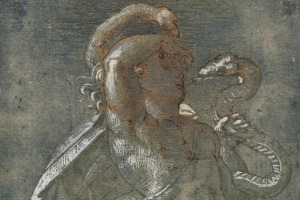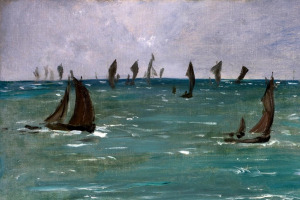Caesura in Beowulf: Function of the Caesura in the Epic Poem
 The caesura in Beowulf occurs in most lines, having an important role. The use of caesura was common for poems at the time, and so Beowulf fits right along with its contemporaries.
The caesura in Beowulf occurs in most lines, having an important role. The use of caesura was common for poems at the time, and so Beowulf fits right along with its contemporaries.
The benefit of caesura in Beowulf also shows us that it was likely an orally told tale. Read this to find out about caesura and its function in the epic poem
What Is a Caesura in Beowulf?
Caesura is defined as a break or pause in a line of poetry, and it is the same in Beowulf. The break comes where one phrase stops and a fresh one starts.
While caesura was used in Ancient Greek and Roman poetry in this way, caesura in Beowulf was used a little differently. Beowulf was written in Old English, hence this pause or break in the lines came to break up a droning phrase.
The usage of caesura is also linked to the use of alliteration in Beowulf. It helps to separate the beats and phrases to make them sound better.
Examples of Caesura in Beowulf
To get a better understanding of caesura and its function, take a look at a few examples of this tool below. All lines are pulled from Seamus Heaney’s translation of the poem. The caesura is represented through a comma or another grammatical marker, to navigate the reader where the pause is.
 Examples include:
Examples include:
- “Asleep from their feasting, insensible to pain”
- “He was numb with grief, but got no respite”
- “High-born and powerful. He ordered a boat”
- “You noblest of men; there’ll be nothing you want for,”
In each example, the caesura is made visible through a period, comma, semi-colon, etc. It shows the reader where to stop or where the phrase ends so that it doesn’t go on forever. One can also see how the caesura coincides with alliteration in the poem. Alliteration is the repeated use of the same initial sounds or letters.
In Beowulf, alliteration instead of rhyme was the focus of the day, and the caesura was placed at just the right spot in the line. There would be two or three alliterative sounds before that pause. And then the same alliterative sound would follow in the beginning soon after the caesura.
Examples of Obvious Alliteration Alongside Caesura in Beowulf
Each line in Beowulf contains alliteration, but there are some places where it’s more obvious than others. Take a look at how the caesura separates the alliteration with some alliterative sounds before the break, and then one after the break. Having in mind that it’s a little trickier and not as accurate since the poem was translated from Old English.
Examples include:
- “Greedy and grim, he grabbed thirty men”: the “gr” sound is repeated before and after the caesura
- “Over the waves, with the wind behind her”: the “w” sound
- “And moored their ship. There was a clash of mail And a thresh of gear. They thanked God For that easy crossing on a calm sea”: this is a longer one because we see the repeated sound over a few lines. “Sh” and “th” (break), “th” and “sh” (break), “th” and sh” (break) “th and th”.
The Function of the Caesurae in Beowulf
The purpose of a caesura in Beowulf includes showing a pause and separating stressed syllables. In some poetry, it is to put an extra beat in to not throw off the meter. However, due to the time period of Beowulf, the poet wasn’t concerned as much about the meter as other poets did in later poetry.
Meters don’t occur in every line or in the same place in each line. They break the beat and help create a smoother reading transition for those telling the story aloud. Meters also show where one phrase or point ends and another begins. Just like in reading, it’s natural to take a break at the end of a sentence or where you see a comma. It is just the same with caesura.
Summary of Beowulf: Background Information
The epic poem narrates the story of Beowulf, a young and powerful warrior who has to come up against a series of monsters throughout his lifetime. Scholars cannot identify the exact date the poem was written in, but it was somehow between the years 975 to 1025. The poem was written in Old English, at first it was an oral story, just as someone wrote it down, it fits perfectly into the poetry of the day. Its focus is not on rhyme, but on alliteration, and it uses caesura to break up the beats.
The story takes place in Scandinavia in the 6th century. Beowulf hears that the Danes are struggling against a bloodthirsty monster. He goes to them to offer his services as a warrior, and he kills the monster. He also kills that monster’s mother and earns rewards and honor for his achievement.
He later becomes king of his own land, Geatland, and he fights against a dragon at the end of his life. This leads to Beowulf’ death because his skill as a warrior has lessened with age. The story is a perfect example of the heroic code of chivalry in the time period. It is one of the most important works of literature for the western world.
Conclusion
 Take a look at the main points about caesura in Beowulf covered in the article above.
Take a look at the main points about caesura in Beowulf covered in the article above.
- Caesura occurs in most lines in Beowulf, and it has an important role
- It was commonly used in poetry at the time
- In modern English translations, the caesura is denoted by a comma or some other grammatical marker
- In Beowulf, the caesura shows where a pause or break is, and it also breaks up the beats and alliterative sounds
- Alliteration was the order of the day for poetry at the time, not rhyme
- So the caesura would help to break up the number of alliterative beats in the lines
- It would also give readers an idea of where to pause when they read
- It shows the ends of phrases and the starts of others
- It provides a smoother and more dramatic reading experience
- Beowulf is an epic poem written between 975 and 1025. It’s one of the most important works of literature in the western world
The caesura in Beowulf is used similarly in other poems and has been popular since Ancient Greek and Roman poetry. It shows the reader where to pause, where phrases end and begin, and in Beowulf, breaks up the alliterative beats. With caesura, we know that Beowulf was meant to be read aloud, but what if it had never been written down?

